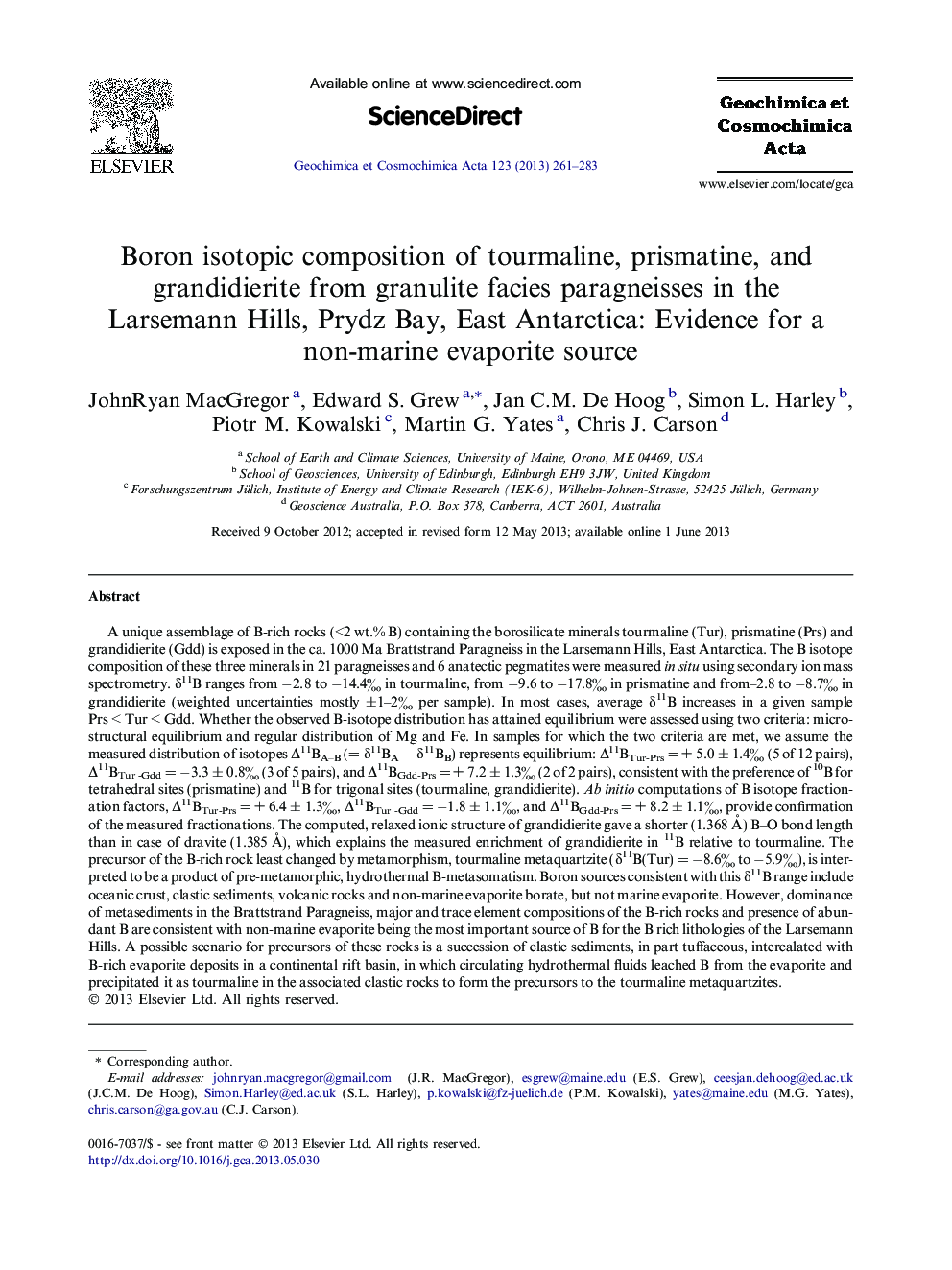| کد مقاله | کد نشریه | سال انتشار | مقاله انگلیسی | نسخه تمام متن |
|---|---|---|---|---|
| 6439093 | 1638034 | 2013 | 23 صفحه PDF | دانلود رایگان |
عنوان انگلیسی مقاله ISI
Boron isotopic composition of tourmaline, prismatine, and grandidierite from granulite facies paragneisses in the Larsemann Hills, Prydz Bay, East Antarctica: Evidence for a non-marine evaporite source
ترجمه فارسی عنوان
ترکیبات ایزوتوپ بور از تورمالین، پرسموتین و گراندی اریریت از پاراگونیتهای رخساره گرانولیت در تالس لارسمان، خلیج پرسیده، قطب جنوب شرق: شواهد برای منبع تبخیری غیر دریایی
دانلود مقاله + سفارش ترجمه
دانلود مقاله ISI انگلیسی
رایگان برای ایرانیان
موضوعات مرتبط
مهندسی و علوم پایه
علوم زمین و سیارات
ژئوشیمی و پترولوژی
چکیده انگلیسی
A unique assemblage of B-rich rocks (<2 wt.% B) containing the borosilicate minerals tourmaline (Tur), prismatine (Prs) and grandidierite (Gdd) is exposed in the ca. 1000 Ma Brattstrand Paragneiss in the Larsemann Hills, East Antarctica. The B isotope composition of these three minerals in 21 paragneisses and 6 anatectic pegmatites were measured in situ using secondary ion mass spectrometry. δ11B ranges from â2.8 to â14.4â° in tourmaline, from â9.6 to â17.8â° in prismatine and from-2.8 to â8.7â° in grandidierite (weighted uncertainties mostly ±1-2â° per sample). In most cases, average δ11B increases in a given sample Prs < Tur < Gdd. Whether the observed B-isotope distribution has attained equilibrium were assessed using two criteria: microstructural equilibrium and regular distribution of Mg and Fe. In samples for which the two criteria are met, we assume the measured distribution of isotopes Î11BA-B (= δ11BA â δ11BB) represents equilibrium: Î11BTur-Prs = + 5.0 ± 1.4â° (5 of 12 pairs), Î11BTur -Gdd = â3.3 ± 0.8â° (3 of 5 pairs), and Î11BGdd-Prs = + 7.2 ± 1.3â° (2 of 2 pairs), consistent with the preference of 10B for tetrahedral sites (prismatine) and 11B for trigonal sites (tourmaline, grandidierite). Ab initio computations of B isotope fractionation factors, Î11BTur-Prs = + 6.4 ± 1.3â°, Î11BTur -Gdd = â1.8 ± 1.1â°, and Î11BGdd-Prs = + 8.2 ± 1.1â°, provide confirmation of the measured fractionations. The computed, relaxed ionic structure of grandidierite gave a shorter (1.368 Ã
) B-O bond length than in case of dravite (1.385Â Ã
), which explains the measured enrichment of grandidierite in 11B relative to tourmaline. The precursor of the B-rich rock least changed by metamorphism, tourmaline metaquartzite (δ11B(Tur) = â8.6â° to â5.9â°), is interpreted to be a product of pre-metamorphic, hydrothermal B-metasomatism. Boron sources consistent with this δ11B range include oceanic crust, clastic sediments, volcanic rocks and non-marine evaporite borate, but not marine evaporite. However, dominance of metasediments in the Brattstrand Paragneiss, major and trace element compositions of the B-rich rocks and presence of abundant B are consistent with non-marine evaporite being the most important source of B for the B rich lithologies of the Larsemann Hills. A possible scenario for precursors of these rocks is a succession of clastic sediments, in part tuffaceous, intercalated with B-rich evaporite deposits in a continental rift basin, in which circulating hydrothermal fluids leached B from the evaporite and precipitated it as tourmaline in the associated clastic rocks to form the precursors to the tourmaline metaquartzites.
ناشر
Database: Elsevier - ScienceDirect (ساینس دایرکت)
Journal: Geochimica et Cosmochimica Acta - Volume 123, 15 December 2013, Pages 261-283
Journal: Geochimica et Cosmochimica Acta - Volume 123, 15 December 2013, Pages 261-283
نویسندگان
JohnRyan MacGregor, Edward S. Grew, Jan C.M. De Hoog, Simon L. Harley, Piotr M. Kowalski, Martin G. Yates, Chris J. Carson,
